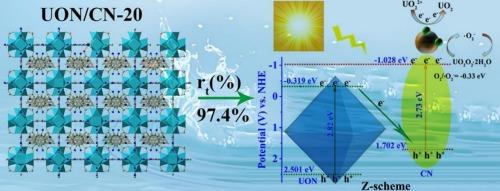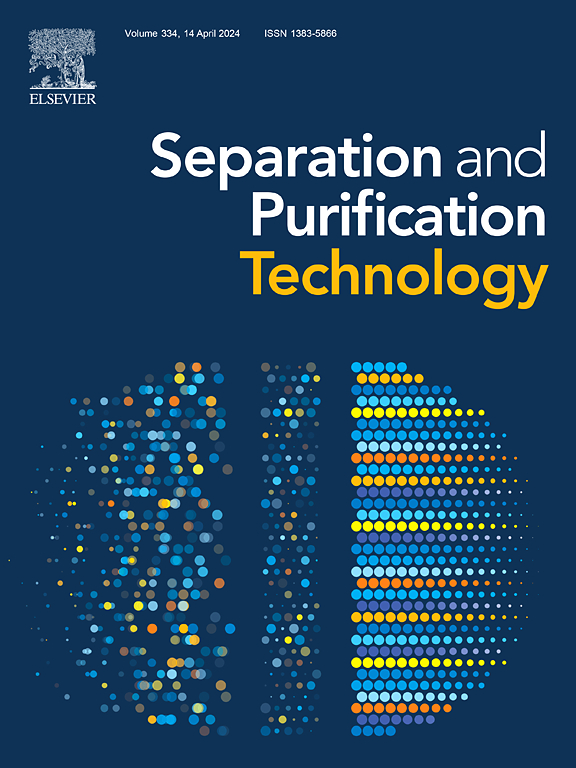UiO-66-NH2/g-C3N4异质结在可见光下增强光催化还原U(VI)的构建
IF 9
1区 工程技术
Q1 ENGINEERING, CHEMICAL
引用次数: 0
摘要
有效地从水溶液中分离铀对核工业的可持续发展和确保环境安全至关重要。本研究采用简单的溶剂热法合成了一系列异质结构复合光催化剂(UON/CN)。这些复合材料由UiO-66-NH2 (UON)和g-C3N4 (CN)组成,设计用于在光照条件下降低U(VI)。在所有合成的复合材料中,UON/CN-20变型表现出最佳的光催化性能,在1.5 h的可见光照射下,U(VI)的分离率达到97.4% %,在抗坏血酸(AA)作为牺牲剂存在下,表观速率常数为2.97 h−1。此外,UON/CN-20复合材料具有良好的可重复使用性和稳定性,即使经过5次循环,U(VI)的分离率仍保持在90% %以上。在UON/CN-20复合材料中观察到的优越的光催化性能主要归因于两个关键因素:(1) CN的加入显著增强了UON的光吸收能力,同时有效地分离了光感应产生的电子-空穴对,为水的氧化反应提供了活性位点;(2)UON中存在的氨基作为U(VI)还原的有效结合位点,从而提高了吸附能力,进一步降低了U(VI)所需的还原电位。本研究提出了一种有效的基于uio -66的光催化剂,其具有良好的稳定性和优异的光催化活性,非常适合在环境修复中应用。本文章由计算机程序翻译,如有差异,请以英文原文为准。


Construction of UiO-66-NH2/g-C3N4 heterojunction for enhanced photocatalytic reduction of U(VI) under visible light
Effectively isolating uranium from aqueous solutions is crucial for the sustainable development of the nuclear industry and for ensuring environmental safety. In this study, a series of heterostructured composite photocatalysts (UON/CN) were synthesized using a straightforward solvothermal method. These composites, consisting of UiO-66-NH2 (UON) and g-C3N4 (CN), were designed to reduce U(VI) under illuminated conditions. Among all synthesized composite materials, the UON/CN-20 variant demonstrated optimal photocatalytic performance, achieving a U(VI) separation ratio of 97.4 % after 1.5 h of visible light exposure, with an apparent rate constant of 2.97 h−1 in the presence of ascorbic acid (AA) as a sacrificial agent. Furthermore, the UON/CN-20 composite exhibited excellent reusability and stability, maintaining a U(VI) separation ratio greater than 90 % even after five cycles. The superior photocatalytic performance observed in the UON/CN-20 composite can be primarily attributed to two key factors: (i) The incorporation of CN significantly enhanced the light absorption capacity of UON while effectively separating electron-hole pairs generated by light induction and providing active sites for oxidation reaction of water, (ii) The amino groups present in UON acted as efficient binding sites for U(VI) reduction, thereby promoting adsorption capacity and further lowering the reduction potential required for U(VI). This study presented an effective UiO-66-based photocatalyst, distinguished by its remarkable stability and outstanding photocatalytic activity, making it well-suited for applications in environmental remediation.
求助全文
通过发布文献求助,成功后即可免费获取论文全文。
去求助
来源期刊

Separation and Purification Technology
工程技术-工程:化工
CiteScore
14.00
自引率
12.80%
发文量
2347
审稿时长
43 days
期刊介绍:
Separation and Purification Technology is a premier journal committed to sharing innovative methods for separation and purification in chemical and environmental engineering, encompassing both homogeneous solutions and heterogeneous mixtures. Our scope includes the separation and/or purification of liquids, vapors, and gases, as well as carbon capture and separation techniques. However, it's important to note that methods solely intended for analytical purposes are not within the scope of the journal. Additionally, disciplines such as soil science, polymer science, and metallurgy fall outside the purview of Separation and Purification Technology. Join us in advancing the field of separation and purification methods for sustainable solutions in chemical and environmental engineering.
 求助内容:
求助内容: 应助结果提醒方式:
应助结果提醒方式:


